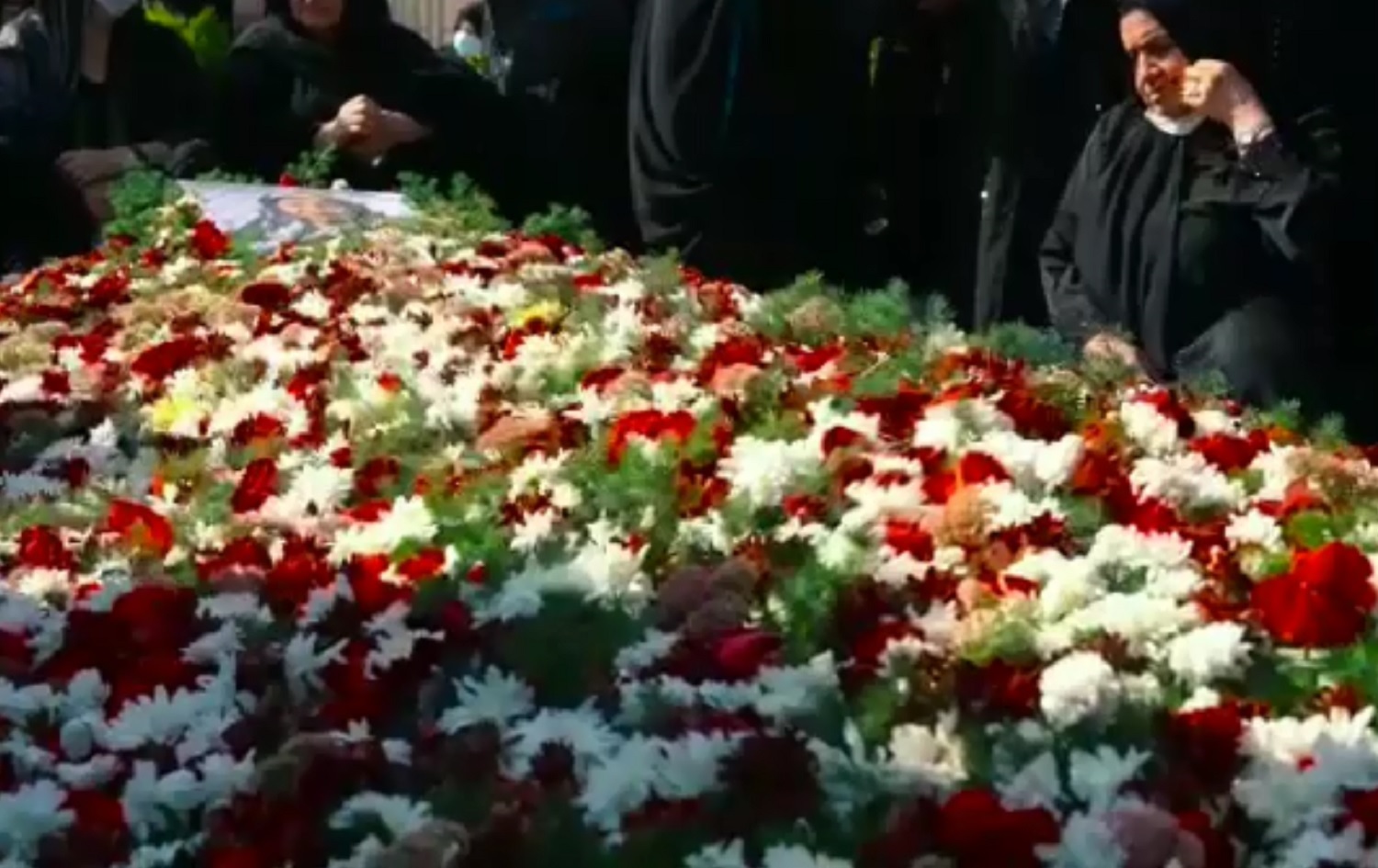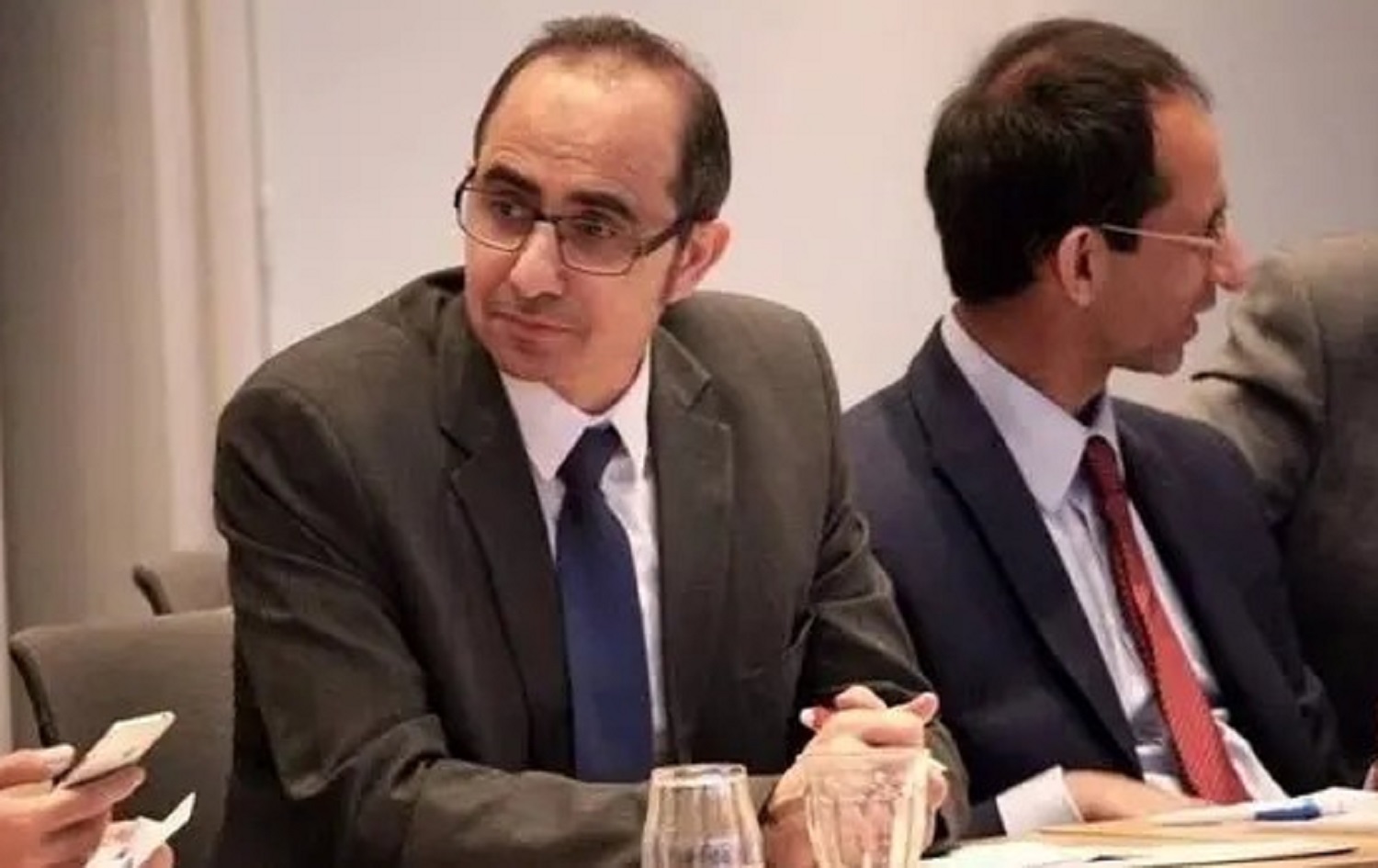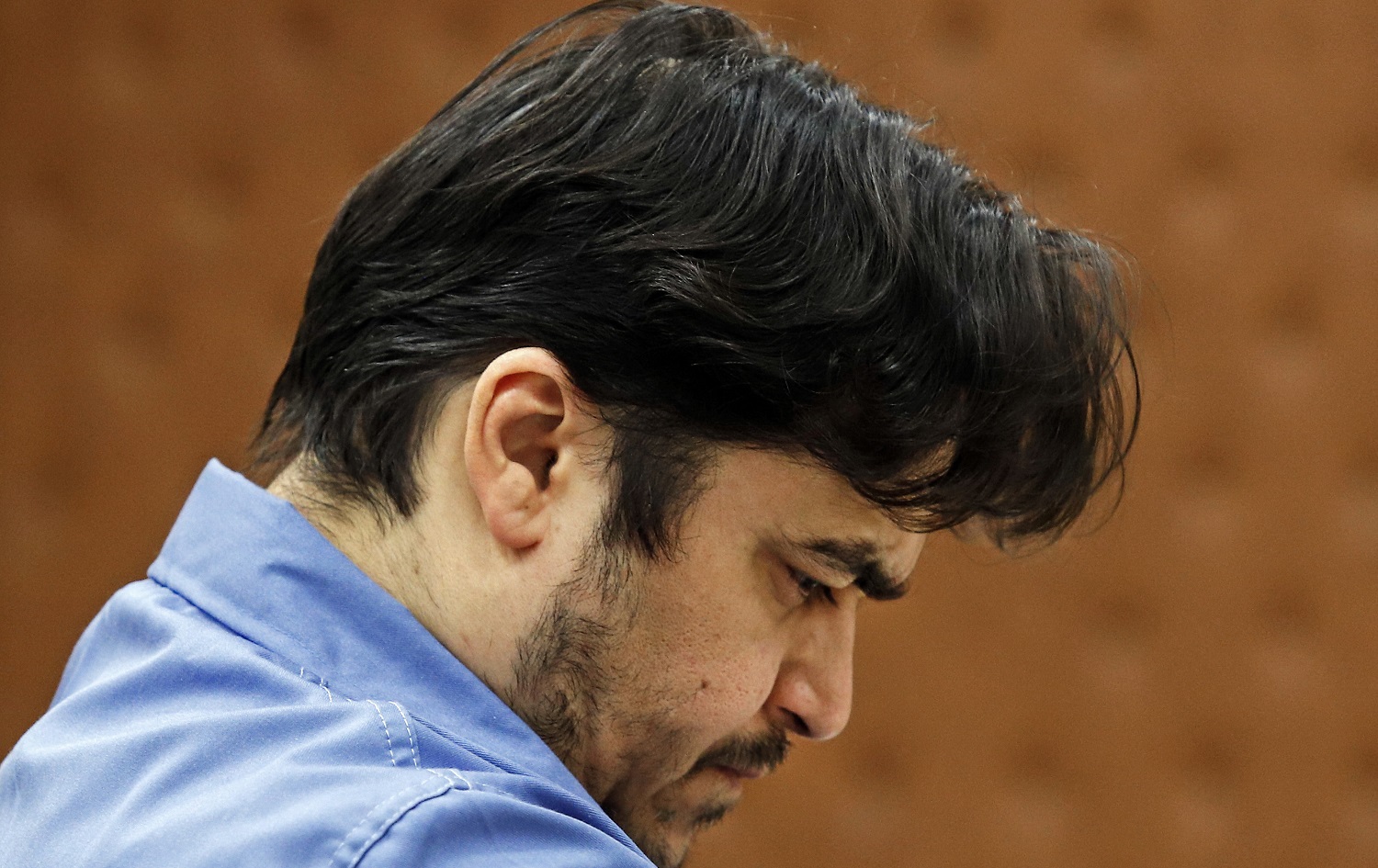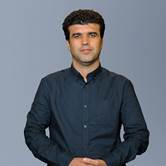
Naji Sharifi Zindashti attends the funeral he organised for his mother in September 2020. Photo: screenshot taken from video posted to a local Telegram channel
ERBIL, Kurdistan Region – As summer drew to an end in northwest Iran, an elderly matriarch took her last breath. Nafia Karimi’s son threw a grandiose funeral ceremony to be attended by thousands. He headed a convoy of scores of vehicles in his BMW 530i through the lush plains around Lake Urmia, the family's place of origin.
The grand funeral was highly unusual, not only because it occurred during a pandemic that had killed over 20,000 people nationwide, but because the man holding it was a drug baron at the service of the Iranian intelligence services.
Naji Sharifi Zindashti, in his late thirties, was seen in a video of the funeral thanking well-wishers in a black, fake Dolce & Gabbana t-shirt with a crown emblem.
Three months later, Zindashti found his name scattered across international media pages, named the orchestrator of a sophisticated Iranian intelligence operation to lure, drug and abduct an Iranian dissident from Istanbul, and smuggle him across the border into Urmia to be handed over to intelligence authorities.

Zindashti came from a family highly respected by Urmia's Kurds. His grandfather, Omar Khan Sharifi Zindashti, was a leading figure during the Kurdistan Republic in Mahabad, where the Kurds tried to establish self-rule in the mid-1940s. The mere participation of his grandfather in the Republic remains a badge of honour for the family.
Zindashti’s father Gorgin was a commander of over 60 peshmerga fighters for the Kurdistan Democratic Party of Iran (KDPI), the leading Kurdish group fighting what was the new regime in Tehran in the 1980s. Gorgin died in late March 1983, in a fierce battle with the Islamic Revolutionary Guard Corps (IRGC) near his home village. Naji’s brother Farhang died fighting IRGC and Iranian security forces alongside his father, Rostam Jahangiri, a veteran KDPI commander and a local of the Urmia area told Rudaw English on Tuesday.
With a family history of rebellion and valour in mind, many who knew the Zindashtis were left deeply shocked by Naji’s involvement in abducting dissidents. One member of the KDPI called the operation Naji had taken part in “a dangerous warning for the Kurdish movement in East Kurdistan [Iran].”
“The head of the bandits was Naji Shariji Zindashti, a member of the family of a peshmerga martyr. But he has been involved in smuggling narcotics and is involved with Turkish MIT and the IRGC,” KDPI member Abdullah Hicab wrote on Facebook.
The operation in question involved the detention of Habib Chaab a Sweden-based dissident part of Iran’s Arab minority. Chaab led the Swedish branch of the Arab Struggle Movement for the Liberation of Ahvaz (ASMLA) accused of a deadly attack on a military parade in September 2018 in the city of Ahvaz, which killed around 30 people, including members of the IRGC. With no warning to his friends, family or acquaintances, Chaab travelled to Istanbul on October 9 to meet his ex-wife. The trip was going to be short; Chaab planned to leave Turkey on October 15. His ex-wife, Saberin S., had travelled to Turkey on October 8 on a forged Iranian passport, and is believed to have been working with the Iranian intelligence service. It is not clear if Zindashti was involved in the actual abduction, but at least 11 members of his drug trafficking group were.

Naji Sharifi Zindashti was born in the village of Zindasht, the Plain of Heaven, around 50 kilometers east of the Turkish border.
The area surrounding Zindasht, in West Azerbaijan province, draws migrants from Afghanistan, Pakistan and Iran, who want to travel illegally to Turkey and beyond. That rugged border area, difficult to police, is also home to the smuggling of drugs and weapons.
Zindashti had been detained in Iran for drug smuggling in the early 2000s and incarcerated in Evin Prison north of the capital Tehran, a local drug smuggler familiar with Zindashti’s drug operation told Rudaw English through an intermediary because of the sensitivity of the matter. It is not clear why Zindashti was then released by the Iranian authorities, but he appears to have traveled to Turkey in the mid-2000s and settled in the Istanbul area. In September 2007, he was caught in possession of 75 kilograms of heroine in the Istanbul suburb of Buyukcekmece. He testified to the Istanbul public prosecutor Zekeriya Oz as an anonymous secret witness for a much larger-scale case, and was let off the hook.
He tried to obtain Turkish citizenship with the help of a top legal advisor to the ruling Justice and Development Party (AKP) in 2011, but appears to have failed.
The next time Zindashti made headlines was in June 2014, when his daughter Arzu was killed in Istanbul by a drug cartel that had accused him of reporting their incoming, two-tonne heroin shipment to the Greek authorities. Arzu and her cousin died when the Jeep they were in was peppered with bullets. The assassins believed that Zindashti himself had been in the car. In the two years that followed assassinations took place in Canada, Dubai, Iran, Istanbul, Panama – all apparently in retaliation for his daughter’s murder. He was detained again in Istanbul alongside half a dozen men for murder-related charges in April 2018, but was acquitted.
Season of abductions
Iran intelligence service operations looked to be in full throttle in the autumn of last year, when they conducted a series of brazen political assassinations, as well as the abductions and transfers of suspects across international borders into Iran, where they would stand trial, then face execution.
Early in the season, President Hassan Rouhani’s own brother Hossein Fereydoun was imprisoned for five years for receiving bribes in a massive corruption case. The newly-appointed head of the judiciary Ebrahim Raisi, a hardliner with strong links to the IRGC, had pledged a crackdown against corrupt figures in the establishment with the blessing of Supreme Leader Ali Khamenei.
Fereydoun’s accomplice, Rasoul Danialzadeh, had allegedly fled Iran – but by November 13, Iranian media reported that IRGC agents had repatriated the accomplice from abroad, secretly filmed video placing Danielzadeh in locations including Dubai.
On the night of November 14, a figure ran alongside two men walking through Istanbul’s Sisli neighborhood, fired a load of bullets into one of the men, then fled the scene. The man killed, Masoud Molavi Vardanjani, had allegedly worked in cyber-security for the Iranian defence ministry’s with pride, but had fled the country a year before his gruesome end.
The Turkish authorities rounded up suspected perpetrators, who claimed to have received their orders from two intelligence agents at the Iranian consulate in Istanbul. Molavi’s companion on the night of his murder was named as Ali Esfanjani, an Iranian intelligence operative. Esfanjani was smuggled back into Iran by a drug smuggler three days after the assassination via the Agri region of easternmost Turkey. It is not clear if Zindashti was the man who smuggled him across the border, but he did operate in the area and was a key asset of Iranian intelligence there.
“The killing… is yet another tragic example in a long string of suspected Iran-backed assassination attempts outside of Iranian soil. The regime’s brutality and amorality know no international boundaries,” US Secretary of State Mike Pompeo said of Molavi’s assassination.
Most momentous has been the detention and abduction of Ruhollah Zam, an Iranian activist and journalist based in Paris. On October 12, Zam was lured into Baghdad, where Iran-backed militia groups ready to do Tehran dirty work. Just two days later, Iranian TV channels were lauding IRGC intelligence agents for their cross-border abduction of the dissident, as footage of a blindfolded Zam being bundled into the back of the back of vehicle was screened.
Zam was executed on Saturday on charges of "corruption on earth" and working with a hostile country. His body was left hanging from the gallows for 20 minutes before it was taken down. He could not write up a will, because the authorities refused to inform him about his death sentence.

These days, Zindashti resides in one of his several villas in Urmia. How Zindashti became an asset for the Iranian intelligence service is not clear, but the castle-like homes he has built in the area indicate some of its reward. Among these homes is one in the village of Mamkan, where locals say Zindashti’s mother was buried in early September. Drones documented the funeral ceremony he organised for her, a sea of men in suits in frame.
The intelligence services of both the IRGC and the government have been accused of hiring criminal gangs to target dissident figures and groups in France, the Netherlands and Denmark in recent years, and a Iranian diplomat is standing trial in Belgium on charges of plotting a bombing on an opposition rally in Paris. The likes of Zindashti have proved to be invaluable asset for cross-border Iranian intelligence operations, and there’s no sign of that changing any time soon.
An immediate relative of Zindashti in Iran told Rudaw English via telephone on Tuesday that the family were unaware of the charges against him until they had seen reports in the media. The family do not know of ZIndashti's whereabouts, the relative said, and they are not in contact with him.
Additional reporting by Khazan Jangiz
Updated at 9:32 pm









Comments
Rudaw moderates all comments submitted on our website. We welcome comments which are relevant to the article and encourage further discussion about the issues that matter to you. We also welcome constructive criticism about Rudaw.
To be approved for publication, however, your comments must meet our community guidelines.
We will not tolerate the following: profanity, threats, personal attacks, vulgarity, abuse (such as sexism, racism, homophobia or xenophobia), or commercial or personal promotion.
Comments that do not meet our guidelines will be rejected. Comments are not edited – they are either approved or rejected.
Post a comment